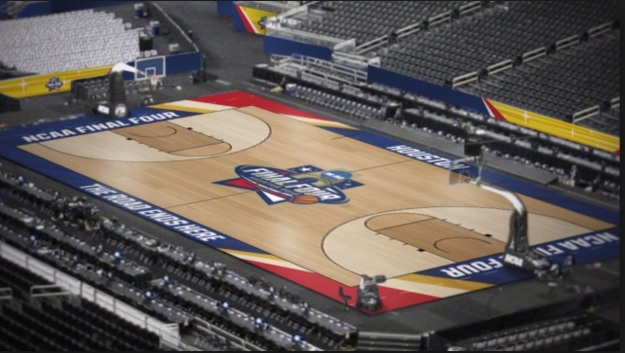
One thing that struck me about the build-up to this national championship game was that initially there seemed to be a fair degree of reticence on the question of how to talk about this national championship game.
North Carolina is favored over Villanova, but only slightly. There’s a decent chance no player in this game will be selected in the first round of the NBA draft this summer, so there’s no obvious “We must stop player X” narrative urging itself upon our consideration. (UNC’s Brice Johnson is currently showing up somewhere between the high 20s and low 30s on the mocks.)
Obviously the Tar Heels have size on their side, while the Wildcats have been shooting stupefyingly well. But with the opposing teams in question being very good but by no means legendary with respect to speed and defense, respectively, it’s tough to spin strength-on-strength yarns.
Frankly it wasn’t until I started finding incredible player stats from the past five games that I realized something very weird has been afoot here all along. With only a minor exception here and there, basically every single player in this national championship game is having a phenomenal tournament on offense. You don’t see that every year on Monday night. In fact I can’t recall ever seeing it.
And all of those incredible individual performances have summed to two historically good offenses. There’s your strength-on-strength. Which amazing offense can outscore the other amazing offense?
We’ve seen 30 teams reach Monday night over the past 15 tournaments, and guess where Villanova and North Carolina rank amidst all those great offenses in terms of the scoring they’ve recorded during their respective five-game tournament runs….
Best tournament offenses in a national final
NCAA tournament games only, 2002-16
Not including title game
PPP: points per possession
PPP 1. Villanova 2016 1.32 2. North Carolina 2016 1.32 3. Wisconsin 2015 1.27 4. Florida 2007 1.24 5. Memphis 2008 1.24 6. Duke 2010 1.22 7. Ohio State 2007 1.21 8. Louisville 2013 1.20 9. North Carolina 2005 1.19 10. Kentucky 2014 1.17
The Tar Heels have been consistently outrageous on offense over the last five games, notching between 1.19 (Florida Gulf Coast) and 1.54 points per trip (Notre Dame) every time out. Conversely Villanova actually scored less than a point per possession in the hard-fought win over Kansas in the Elite Eight. Who knew that what the Jayhawks were doing in the course of an “upset” loss would look so impressive in retrospect?
A belated salute to the KU defense for making Nova miss shots. No one else has even come close to doing so.
— John Gasaway (@JohnGasaway) April 2, 2016
On the other hand, in the Wildcats’ four games where the opponents’ jerseys did not say “KANSAS,” Jay Wright’s team has scored a rather robust 1.41 points per trip.
It won’t surprise you to learn that these two offenses have attained identical and unbelievable levels of success in dramatically different ways. UNC’s shooting has been very good but nowhere near as lethal as Villanova’s. That difference has been made up through offensive rebounding and a lack of turnovers. As a team the Heels have pulled in 47 percent of their missed shots in the tournament. In fact in terms of offensive rebound percentage, Kennedy Meeks alone (21.7) during his tournament minutes is equaling or exceeding what we saw this season in conference play from entire teams like Boston College (21.7), Washington State (21.0), or Illinois (18.9). One-man team Kennedy Meeks, I salute you.
As for the Wildcats, they’ve been giving the ball away at a slightly higher rate in the tournament than UNC has, and obviously smallish Nova doesn’t really “do” offensive boards. But little things like turnovers and offensive rebounding tend not to matter when you’re making 49 percent of your threes, and 64 percent of your twos. Granted Ryan Arcidiacono is the third option on offense (taking 18.5 percent of Nova’s tournament shots during his minutes) behind Josh Hart (30.9) and Kris Jenkins (24.6), but the senior’s numbers are instructively crazy so let’s stay with him for a moment. In the tournament Arch has flung the ball toward the rim — either as a two, a three, or a free throw — on a total of 54 occasions, and 40 of those tries have gone in the basket.
Simply put, a collision between two offenses this aberrantly explosive should at a minimum sum to a highly watchable shootout, with definite potential for something more. With luck the game could attain iconic and even adjectival (“2016-good”) status in future years. Here’s hoping for any of the above.
BONUS coverage of both sides of the ball. Here are your best national championship game tournament defenses from the past 15 brackets.
Best tournament defenses in a national final
NCAA tournament games only, 2002-16
Not including title game
Opp. PPP 1. UCLA 2006 0.83 2. Duke 2015 0.87 3. Kansas 2012 0.89 4. Butler 2010 0.89 5. North Carolina 2009 0.89 6. Kansas 2008 0.89 7. Florida 2006 0.90 8. Syracuse 2003 0.91 9. Louisville 2013 0.93 10. Michigan 2013 0.93
I confess that when I was watching Duke in real time in January of 2015, I little imagined that this team would come to epitomize a long-lost golden age of point prevention. Dogged and determined dignitaries of Devil defense, I salute you.
